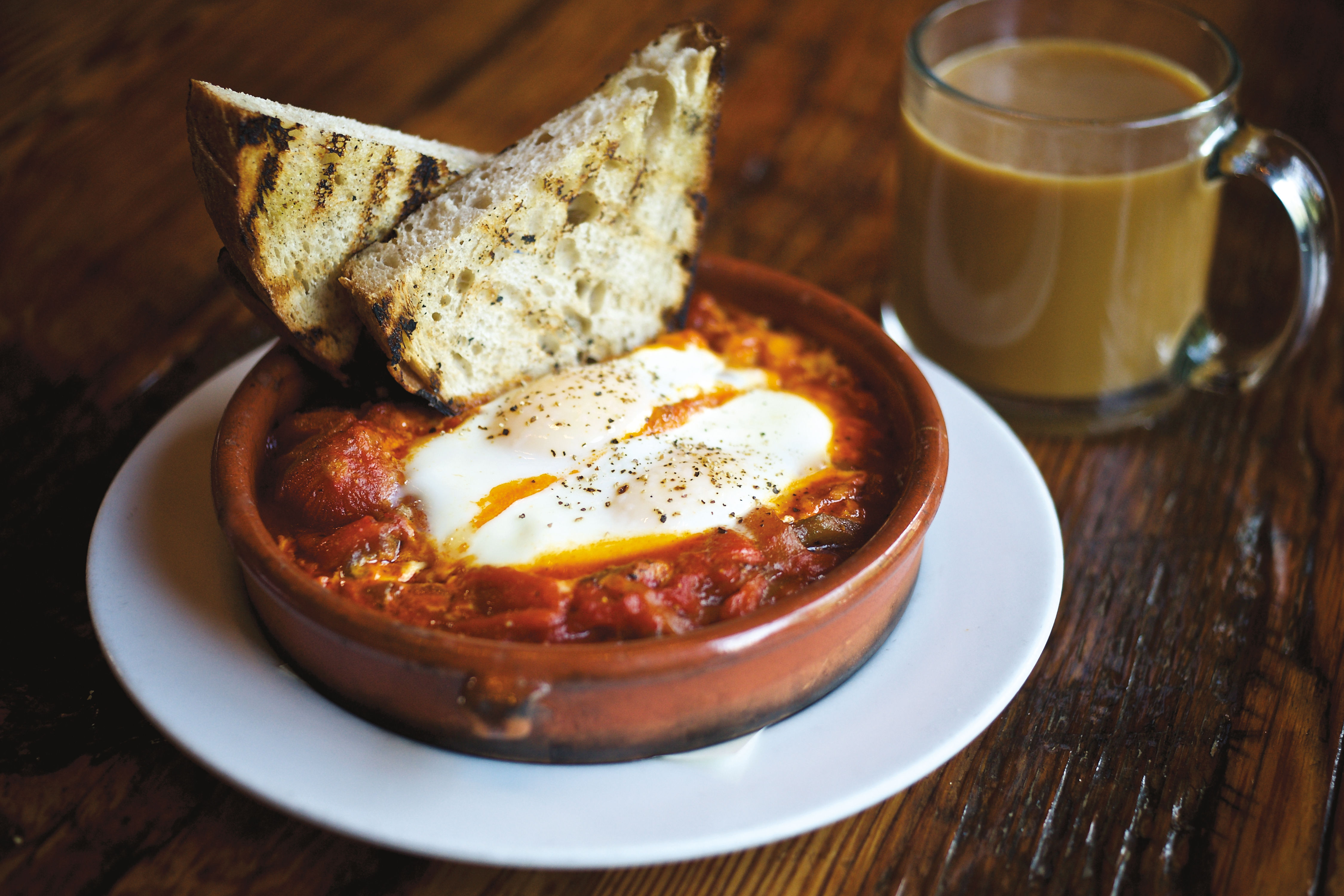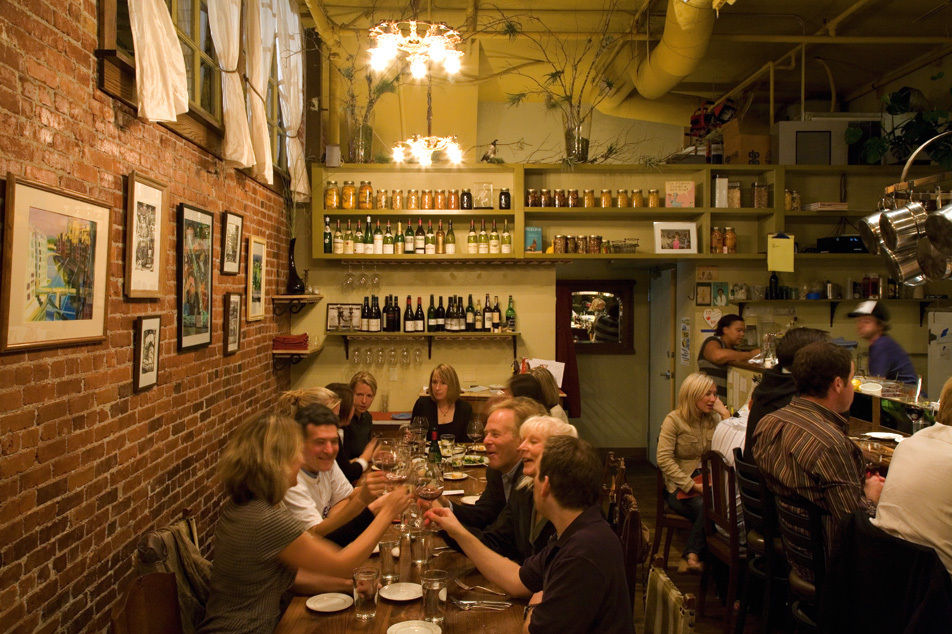
Best Restaurants 2007
When someone asks me for a restaurant recommendation, my answer often unfolds like this: “Do you want casual or fancy? Tapas or tacos? Are you bringing your entire family or just a date? Let me think about it and get back to you.” At which point they throw up their hands and walk away. But really, I do think about it, hard, for a day or two or more, because I want their experience to be excellent, first of all, and secondly, because I believe each diner’s culinary personality should be part of the equation.
In choosing the top 10 restaurants in Portland, however, I don’t have the privilege of knowing every reader’s eating proclivities. Instead, I’ve chosen 10 dynamic dining establishments that have brilliantly realized the atmosphere, tone and cuisine each set out to offer when they opened. Which means that whether it’s a laid-back barbecue joint or an opulent Italian affair, the people who run it never compromise their own style and vision, a fact that anyone can appreciate.
But above all, of course, the food must be good—as consistently good as the food that our Chef of the Year (scroll down) prepares at his superb Northeast tapas restaurant. And it must be served by a talented waiter or waitress—perhaps even someone as skilled as our inaugural Waiter of the Year (scroll down).
So there you have it: Portland’s 10 best restaurants, laid out for you in no particular order. No matter what your gourmet leanings, there’s something here for everyone. Your table is ready …
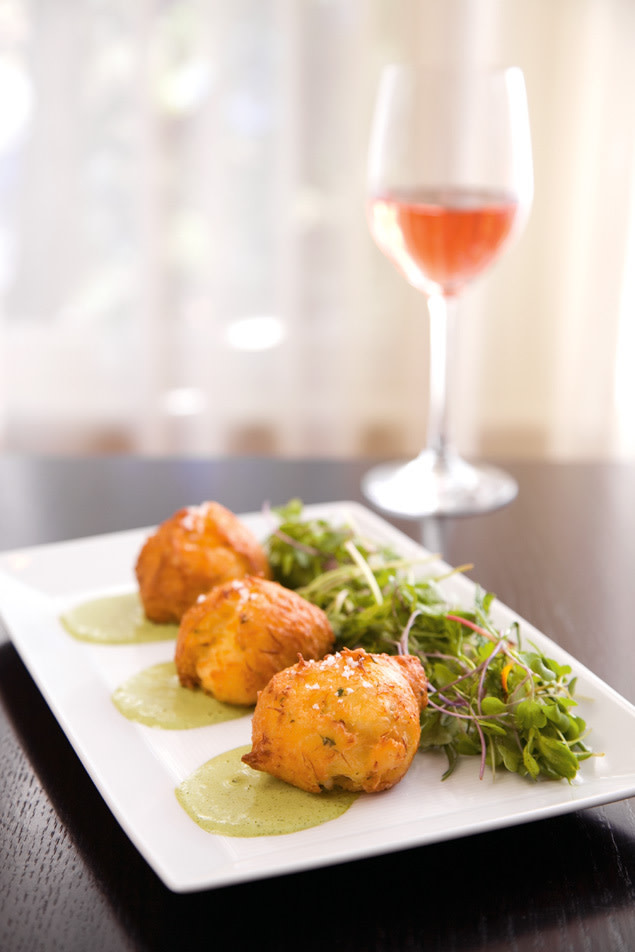
Image: Susan Seubert
Paley's Place
As more and more young, enthusiastic restaurateurs and chefs arrive in Portland, there’s no denying that the pioneering handful of seasonal, local, sustainable restaurants that opened here to national acclaim back in the 1990s have sometimes receded from the critical spotlight—while the newer, hipper restaurants take their turn at winning accolades. But that doesn’t mean the old guard aren’t still churning out some of the best food and service in town. Paley’s Place, that little house of a restaurant tucked away on NW 21st Ave just north of Lovejoy, has for 12 years remained unwavering in its innovative approach to cuisine and in its commitment to graceful solicitousness, not to mention its deep-seated dedication to fresh ingredients from local farmers.
Between Kimberly Paley’s ability to orchestrate the packed dining room with undying spirit and effortless spunk and chef Vitaly Paley’s ability to strike a delicate balance between classic and cutting-edge cuisine, the husband-and-wife team behind Paley’s Place deserve enthusiastic applause. And indeed, those are the qualities that have earned the restaurant a loyal following over the years. It can be difficult, after all, to shake the heady effects of Paley’s escargot à la Bordelaise served with roasted marrow bones, parsley salad and grilled bread on which to spread the velvety marrow. And when the ravioli, stuffed with corn and chanterelles and served in a nage (vegetable broth) of heirloom tomatoes, inspires lush hyperbole, that’s nothing to be ashamed of. Even an amuse-bouche of cold melon soup served in a shot glass whose rim is speckled with tarragon-infused sea salt will convert the most circumspect diner.
These are all dishes that seem, on the surface, easy to execute, but in truth they only work when prepared by a chef who understands the subtleties of each ingredient and can prepare them with a trained, talented hand. In fact, it’s that very talent and knowledge that drive many young, idealistic chefs, upon arriving in town for the first time, to head straight to Paley’s Place in search of guidance from the guru himself. It’s why we’ll always head there too.
1204 NW 21st Ave, 503-243-2403
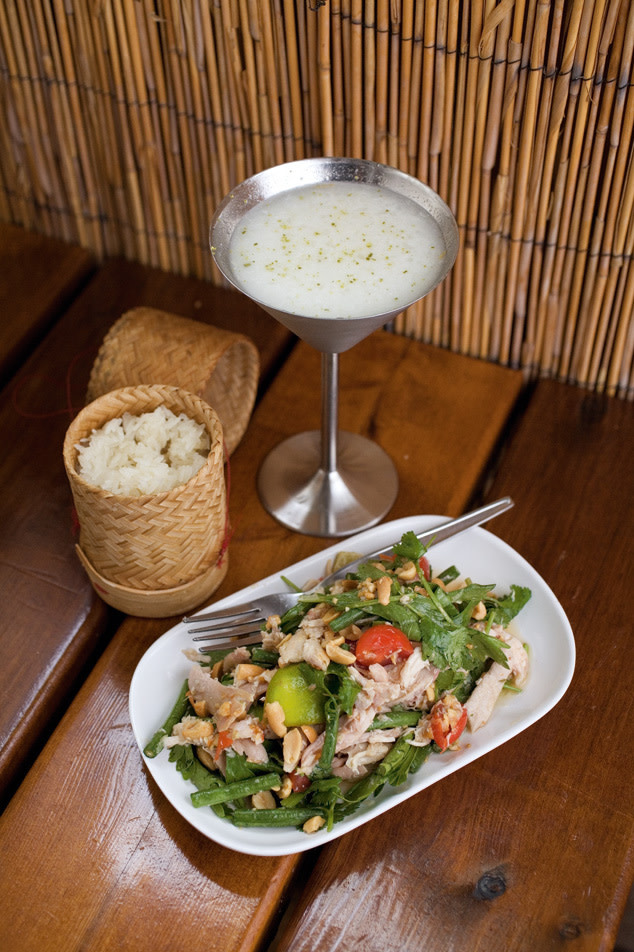
Image: Susan Seubert
Pok Pok / Whiskey Soda Lounge
There's seemingly no end to chef Andy Ricker’s imagination. First, he opened a modest little takeout shack on SE Division St called Pok Pok—named after the sound, in Thai, that a pestle makes when it strikes a mortar. Inspired by the street food he’d eaten during his dozens of travels to northern Thailand since 1988, he served a small menu of authentic Thai dishes such as charcoal-grilled game hen stuffed with lemongrass and a curry noodle soup made with pickled mustard greens, shredded chicken and house-pressed coconut milk. For many patrons, it was difficult to eat anything other than these bewilderingly satisfying and unfamiliar Thai specialties.
But then last winter, Ricker expanded his outdoor restaurant into the basement of the house next door. He called this new, funky, wood-lined dive Whiskey Soda Lounge and offered an expanded menu, but one still dedicated to the specialties of late-night outdoor markets in Southeast Asia. he began pressing his own sugar cane for his quirky cocktails.
He figured out how to deep-fry Vietnamese fish-sauce wings so that they caramelized in the hot rice oil and morphed into something undeniably addictive. He served a noodle soup with a broth rich with the meaty fragrance of lamb and the sweet, earthy scent of mint, as well as a salad of "crispy fried egg" with Chinese celery, Thai chiles and palm sugar that was hauntingly delicious. And among a dozen other entrées and desserts, there was a coconut-and-jackfruit ice cream served on a sweet bun with sticky rice, peanuts, condensed milk and chocolate syrup that sounded and tasted so odd, but was so curiously delicious that it became an instant hit.
And the lines kept growing longer, so Ricker expanded to the upstairs of the little brown house, even installed heat lamps and more tables and tents on the patio so that diners could sit outside year-round. In fact, on balmy nights, the ambitious little culinary complex Ricker has built for himself began to look exactly like the Chiang Mai night markets that inspired it. It would hardly be surprising if Ricker eventually just expanded out into the street, where hundreds of avid Pok Pok fans would surely mill about into the midnight hour, feasting on Gulf prawns baked in clay pots and green papaya salad and lamb kebabs, all wondering what Ricker could possibly come up with next.
3226 SE Division, 503-232-1387
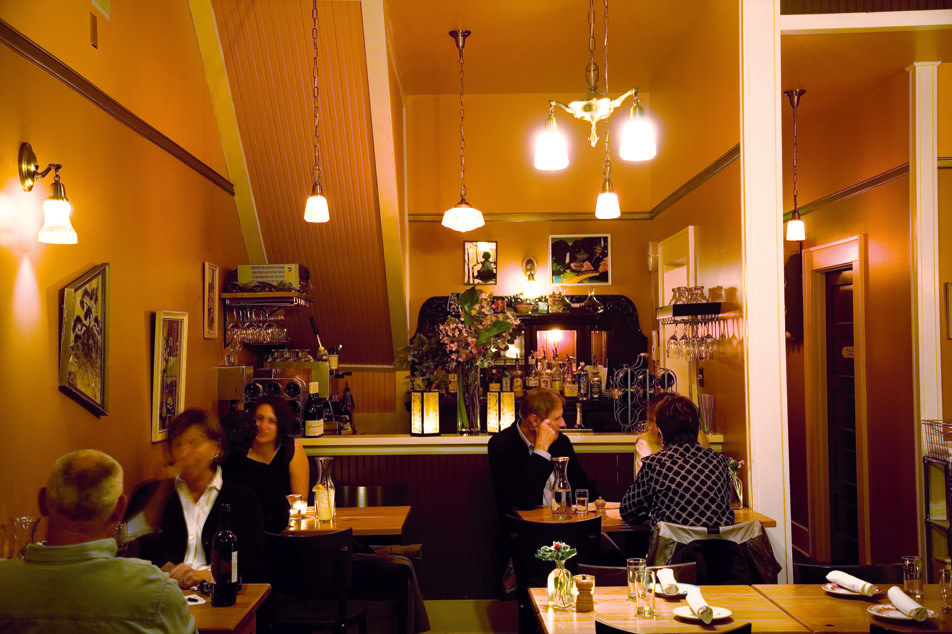
Image: Susan Seubert
Lovely Hula Hands (Now Closed)
Back when it was housed in a bright pink Foursquare, tucked away between N Mississippi and N Interstate Aves, Lovely Hula Hands almost had it right. The shabby-chic décor was invitingly homey and the service hospitable, but the fusion food just didn’t quite gel.
Then last year, owners (and sisters) Sarah and Jane Minnick moved their little eatery five blocks north on N Mississippi Ave to a boxy, bricks-and-mortar, two-story building. With a more solid foundation beneath their feet, they hired chef Troy MacLarty, most recently of now-defunct Family Supper, and everything began to taste a whole lot better.
While the Minnicks have managed to replicate the chintz-charming ambience of their former digs, MacLarty has infused the small menu with a Chez Panisse-inspired passion for seasonal ingredients. Which means that by sautéeing a dozen tiny, green and mild padron peppers from Viridian Farms and sprinkling them with fleur de sel, MacLarty makes them (and other such ingredients) taste more like the earth they came from than when they were picked.
It also means that in August, his signature creamy soufflé is made with sweet corn, summer chanterelles, bright green spinach and cippolini onions; and that in the fall, it contains buttery leeks, roasted cauliflower and celery root. A simple chicken breast paillard comes with a salad of cherry tomatoes, roasted corn, mozzarella and avocado in September, but come December it’s breaded and fried, served over a Moroccan-style chickpea and broccoli ragout.
At once rustic and incredibly fresh, this is American slow food at its finest, served with a signature romantic flair in a dining room that’s very, very easy to come home to.
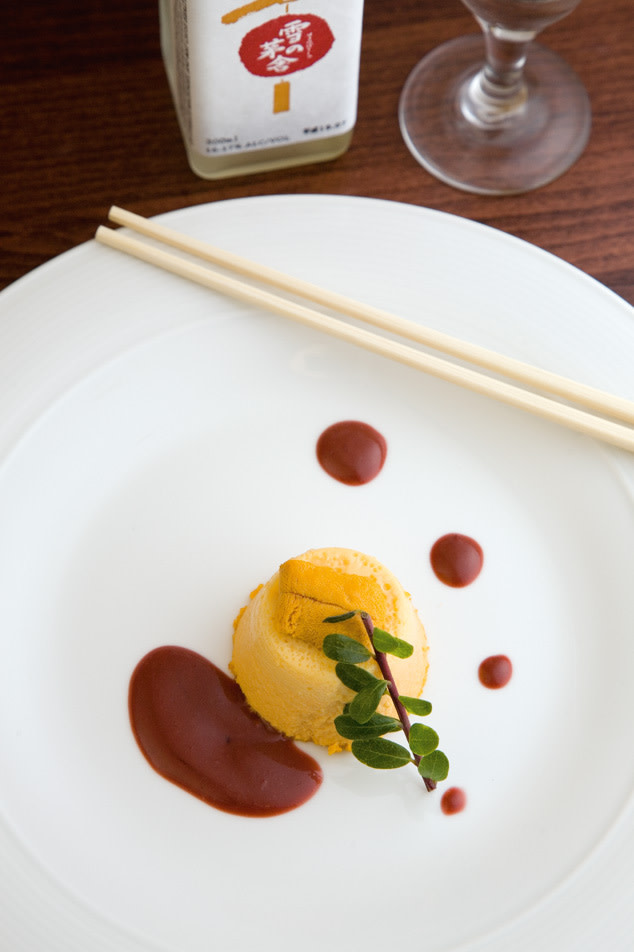
Image: Susan Seubert
Hiroshi (Now Closed)
WHY HAS IT TAKEN SO LONG for our city, perched as it is squarely on the Pacific Rim, to have access to superlative sushi? Seeing as how we’re a lot closer to Japan than New York is, shouldn’t we have had the pleasure first? Plus, if Seattle and San Francisco have had excellent sushi for so long, why haven’t we? Luckily, in the past few years a coterie of sushi masters has finally graced us with their presence, from the skilled chefs at Masu and Masu East to Ryoshiro Murata of Restaurant Murata.
This year, Hiro Ikegaya sits at the top of the local cadre of sushi makers. After closing the doors to his beloved Hiro in Lake Oswego, Ikegaya opened Hiroshi across from Jameson Square in the Pearl. There, his stark beige-and-dark-brown, chapel-like dining room is flanked by a long sushi bar (the best seat in the house), where a stoic Ikegaya and his talented team of chefs crank out some of the most creative and delicate appetizers and sushi in Oregon.
Perhaps most impressive about Ikegaya’s well-polished restaurant, aside from the quality of the fish and the perfectly seasoned sushi rice and the ingenuity of each of his rolls and the lusciousness of his uni custard, is that he prepares from scratch every single dot of sauce on every plate himself. From the wasabi sauce swirled around a plate of ahi tuna tartare to the vinegary miso sauce that’s drizzled over a silky cube of monkfish liver pâté or the ponzu sauce that comes with the fried soft-shell crab, one small drop is all it takes to taste Ikegaya’s commitment to perfection. Which is more than enough to finally pacify—make that pique—the city’s sushi cravings.
926 NW 10th Ave, 503-619-0580
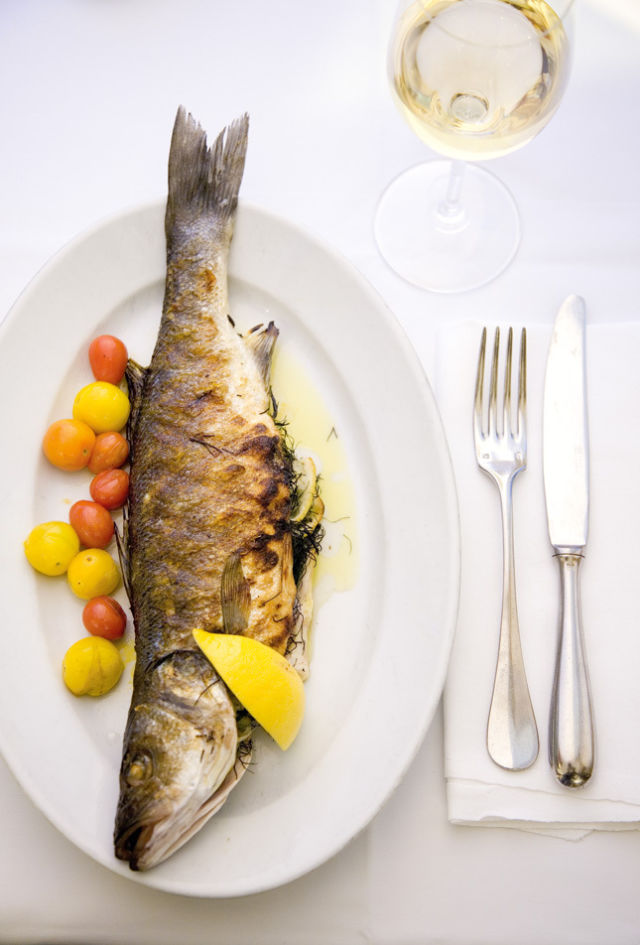
Image: Susan Seubert
CASTAGNA
WHEN IT COMES TO DINING in Portland, most restaurants do the funky, the hip, the casual and even the gritty quite well. We Portlanders feel comfortable in these elements. But the truth is, when it comes to “fine dining” at a mature and polished restaurant, we’re often not so accommodating.
Of course, it may well be that we’re jaded, having watched several Portland restaurateurs attempt such refinement but fail quite miserably at it. But Kevin Gibson and Monique Siu have succeeded—and since opening their elegant restaurant Castagna in 1999, with Gibson heading up the kitchen and Siu overseeing the dining room, they’ve become two of the most respected restaurateurs in town. While its debut was met with citywide acclaim, the sleek, minimalist dining room has been somewhat overshadowed by the more casual (and wildly popular) café the pair opened next door two years later—the kind of place that appeals to the inner fleece-wearer in us all. But with its extremely professional, unobtrusive service (see “Waiter of the Year,” below), a modern atmosphere at once serene and sophisticated, and a refreshingly subtle Italian- and French-inspired menu, Castagna has undeniable staying power.
Having cut their teeth at Bruce Carey’s Zefiro—itself a successful fine-dining restaurant here in the 1990s—Siu and Gibson offer fare that will appeal to any diner, but not at the expense of the nuance sought by those with a more discerning palate. Case in point: A simple piece of coho salmon, grilled medium-rare and served with beans, potatoes and aioli. Where other restaurants might settle for garden-variety green beans, Gibson offers long snake beans (also known as Chinese long beans) whose earthy sweetness elevates the salmon’s unique flavors. The potatoes are the Charlotte variety, with a buttery texture that perfectly complements the moist fish and beans. And the pinch of saffron in the aioli makes all the difference in the dish.
Other combinations likewise transcend their singular parts. An elegant plate of sautéed black cod is drizzled with a sweet cicely cream, sprinkled with steamed cockles and topped with julienned cucumbers and zucchini. Corn soup with crawfish and chives, flavored with nothing but salt and pepper, tastes sunny, golden and sweet. And tiny agnolotti filled with mascarpone and mashed shell beans melt into heavenly, savory air upon hitting the tongue.
Each dish is prepared quietly and humbly, yet their flavors are transformative—culinary riffs akin to the strains of John Coltrane and Billie Holiday that often twinkle through the decidedly refined candlelit room.
1752 SE Hawthorne Blvd, 503-231-7373
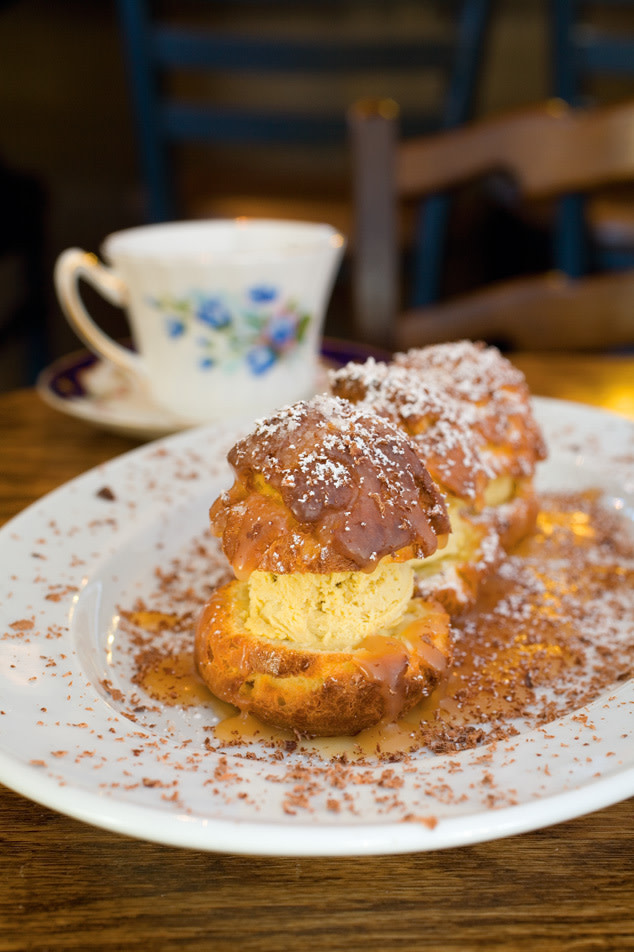
Image: Susan Seubert
LE PIGEON
IN THE YEAR SINCE WE DUBBED the young, exuberant Gabriel Rucker of Le Pigeon our inaugural Chef of the Year, the culinary wunderkind has transformed his tiny E Burnside St kitchen into a nationally recognized gastronomic haven. His food has been featured in Gourmet magazine, and in July Food & Wine voted him one of the 10 best new chefs in America. Luckily, all that attention hasn’t gone to his head—or his food. Rucker and his talented team still love to take risks, and they do so to delightfully refined effect.
Or how else would you characterize smart desserts like foie gras profiteroles that comprise a trio of pillowy cream puffs filled with a sweet and smooth foie gras ice cream? Rucker perfected the ice cream over the course of many trials and errors before getting it just right—right as in enveloping the barely discernible richness of foie gras within the creamy, icy, golden sweetness of vanilla and cream. Other revelations include the light-as-air sweetbreads (sounds like an oxymoron, doesn’t it?), accompanied by a whimsical pickled watermelon salad, and a fluffy aioli that’s subtly flavored with uni (sea urchin).
In fact, one could spend an entire evening here deconstructing the unorthodox genius of Rucker’s flavor pairings in just about every dish—from the beef cheek bourguignon to the seared duck with pancetta vinaigrette. But if doing so means you fail to notice that the dining room is practically bursting at the seams with its own energy, abuzz with diners whose glowing faces register the same wide-eyed giddiness and gusto for Rucker’s cult of culinary devotion that yours does, that, alas, would be a grave mistake.
738 E Burnside, 503-546-8796
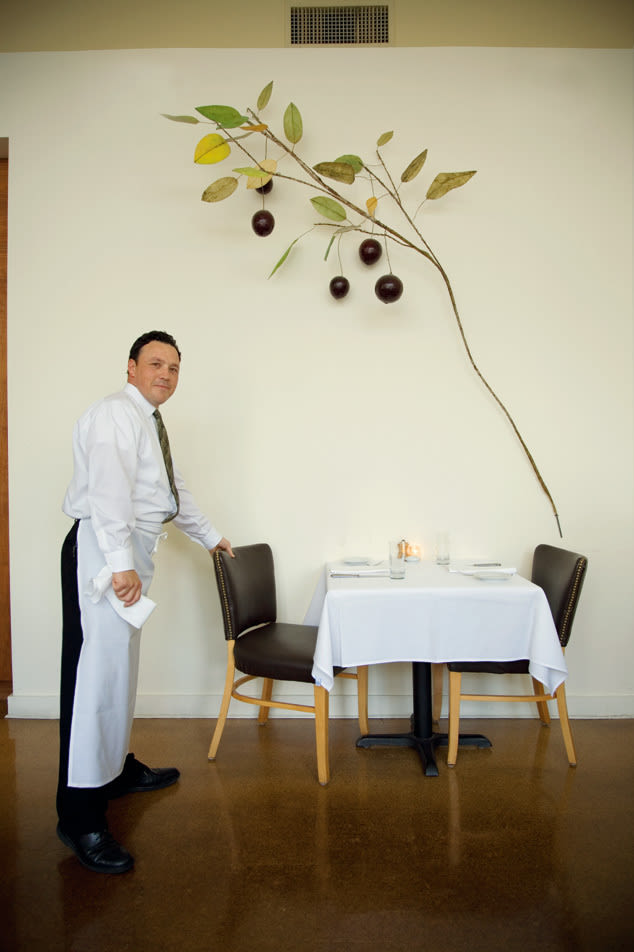
Image: Susan Seubert
WAITER OF THE YEAR
ONE RECENT EVENING, at a trendy local restaurant that will remain unnamed, I witnessed an empty table covered in butcher paper catch on fire after a gust of wind from an open window blew the corner of the paper into a lit candle. There were multiple waiters standing nearby who apparently lacked the peripheral vision needed to notice such a conflagration, so my dining companion and I took it upon ourselves to extinguish the fire with our napkins. Despite the looks of alarm on neighboring diners’ faces and the smell of burnt paper beginning to fill the room, not one of the servers acknowledged what had happened until a half hour later, when one of them finally changed the charred tablecloth—a potent example indeed of the sorry state of restaurant service in Portland.
It’s also a metaphor for what makes the job of a waiter or waitress so challenging. Both literally and figuratively, they’re expected to keep fires from igniting in the dining room and to put out the conflagarations that do flare up—be it preventing a picky eater from throwing a fit or appeasing a customer who’s unhappy with his hanger steak. They’re also responsible for making sure that everyone’s dining pleasure is continually tended to, all without the waiter appearing to try too hard.
It’s a difficult job, yes. But that’s no excuse for not doing it well. And since the majority of servers in Portland don’t do it well, it behooves us to honor those who do. This year, while the service at such restaurants as 23Hoyt, Hurley’s, Country Cat and the Heathman has been especially impressive, no server distinguished him or herself more than SAM GRAYSON AT CASTAGNA.
It’s not just the little things that Grayson does well—serving from the left and clearing from the right, placing the cork on the table after he’s opened a bottle of wine, refolding our napkin while we’re off at the loo—it’s the natural grace with which he performs his job that truly impresses.
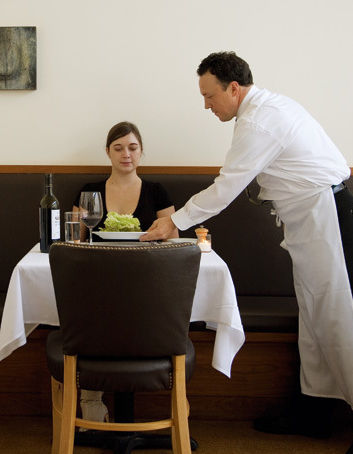
Image: Susan Seubert
He’s talkative without being annoying and attentive without hovering; he recites the specials as though he’s just prepared them himself; and he moves about the dining room with a confidence that’s rarely seen among the young, self-conscious, often awkward army of waiters and waitresses that permeates Portland’s food scene. And he seamlessly manages to keep up with the rhythm of at least a dozen different tables and the kitchen staff, ensuring that our meals are brought out in a timely, elegant manner, while still hot—you’d be surprised at how many places don’t get that particular detail right—which makes our meals all the more satisfying.
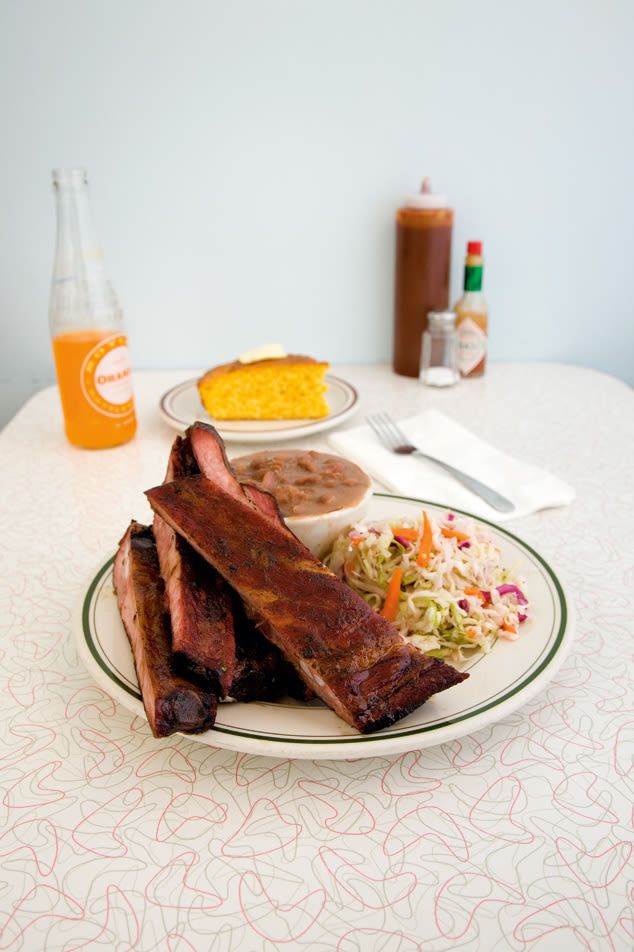
Image: Susan Seubert
PODNAH’S PIT BARBECUE
AT THE RISK OF SPARKING RIOTS in Texas, Kansas, Missouri and North Carolina, we’ll say it: All barbecue tastes somewhat good. Because on a very basic level, slow-cooked meat slathered in a salty, sweet, savory and sour sauce appeals to just about every part of the tongue. But only a very few places in the country turn out barbecue that justifiably can be called sublime.
Up until early this year, the majority of ’cue joints in Portland were just somewhat good; the sauce was all sugar and no bite, or the meat was dry, and so on. But then Texas native Rodney Muirhead opened Podnah’s in an unassuming storefront at NE Prescott & 15th, complete with a gargantuan, custom-made smoker out back and an endless pile of hard oak coming through the front door.
Never mind the sparseness of the dining room and the quick-witted gruffness of the waiters—such features only serve to highlight the single reason for coming here: to feast on sublimely succulent, slow-smoked meats, from dry-rubbed pork spareribs to salted-and-peppered lamb spareribs; from smoky chicken to a pork shoulder, pulled and tossed with a tart North Carolina-style vinegar sauce.
Every other aspect of Muirhead’s menu is as authentically rendered too. The iceberg wedge smothered in homemade bleu cheese is nearly perfect, and the pecans in the pecan pie are sweetened with real cane syrup, baked in a crust made with authentic leaf lard (which comes from the fat around the animal’s kidney) and topped with “cold whoop.”
At last, honest-to-goodness barbecue—with all the right fixins—that transports us out of the realm of just-good-enough and into the realm of downright delicious.
1469 NE Prescott, 503-281-3700

Image: Susan Seubert
PARK KITCHEN
FOR EVERY PORTLANDER who just can’t get enough of the experimental Pearl District bistro known as Park Kitchen, there is an equal number of Portlanders who “just don’t get it.” But perhaps not “getting” Park Kitchen has to do with the fact that it’s a restaurant whose style and influences are often incredibly hard to pin down.
Lately a Japanese influence has suffused many of the plates, and occasionally diners can discern something vaguely Greek or Italian or Spanish about the food in front of them. But more essentially, the menu here has traveled to the table straight from the quirky, playful and often remote regions of chef Scott Dolich and chef de cuisine David Padberg’s creative minds. A meal at Park Kitchen means you’re submitting to their culinary winks and nods—and therein lies the attraction.
Order the “poached plums, fennel and goat cheese” off the small cold plates portion of the menu, and a trio of poached greengage plums perched atop thick slices of Spanish goat cheese that float above a pool of bright green fennel purée will arrive. “Fried green beans and bacon” translates to battered and fried green beans, served upright in a glass cup lined with butcher paper, alongside decadently battered bacon that’s been dipped into the hot vat. And while the pork belly is just that, it’s served in a bowl of fragrant, meaty apple and matsutake broth that tastes at once like the Vietnamese noodle soup pho and also something more complex than that.
No matter what you choose, however, it’s obvious that, back in the kitchen, the chefs are having unadulterated fun—a rare quality in chefs who are in the business for the long haul, and one that practically ensures there will always be something new under the heat lamps.
422 NW Eighth Ave, 503-223-7275
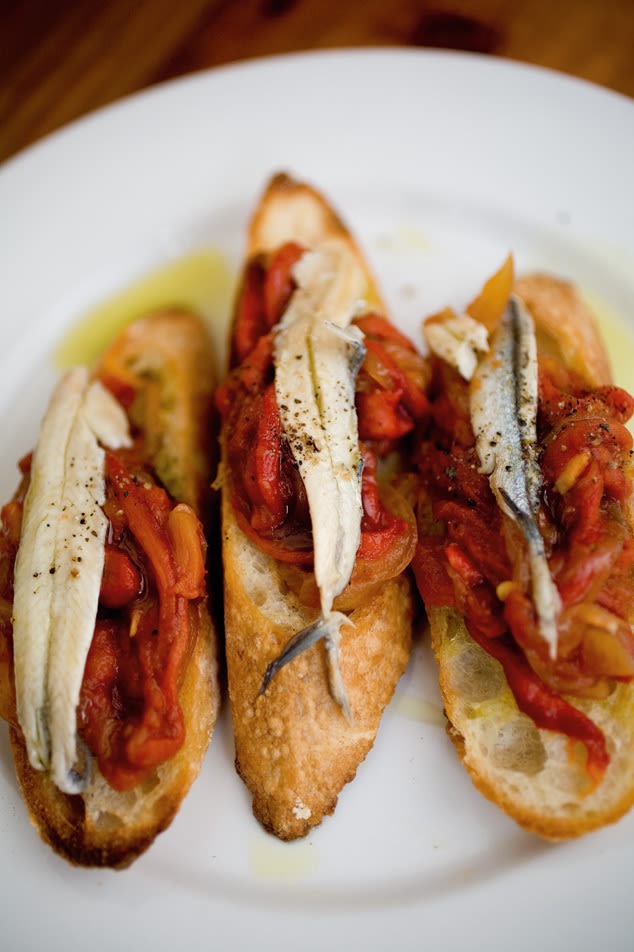
Image: Susan Seubert
TORO BRAVO
TAPAS JOINTS SHOULD BE DEVOID of gimmickry. The music should be minimal, the banter quotient high, and the menu quite long and uncommonly enticing, such that diners find themselves ordering at least half, if not all, of its offerings. One should be able to move from fried fresh anchovies to salt cod fritters to marinated sheep’s cheese to paella to lamb chops in one slow, unfolding symphony, interrupted only by intermezzo swigs of robust Rioja wine.
For Portlanders, no tapas restaurant (of which there are few here) is deserving of such a description more than Toro Bravo, housed in a turn-of-last-century brick building next to the Wonder Ballroom. Before they opened the restaurant in May, John Gorham (see “Chef of the Year,” below), formerly of Simpatica, and his wife, Courtney Wilson-Gorham, who ran the front of the house at Simpatica and before that at Paley’s Place, took a weeklong trip to Spain to research ideas for their venture. The result is an extensive menu that offers more than 40 Spanish-inspired and American-inspired small plates.
Despite the wealth of styles and preparations, however, the design of each of Gorham’s dishes remains decidedly masterful, from griddled shrimp with chiles to crab-and-pork croquettes or a house-smoked coppa steak with olive-oil-poached potatoes. With a deep red dining room crammed with communal and bistro-size tables, a jovial bar and a front-row chef’s counter, he’s managed to import not only the flavors of Spain but also the rambunctious conviviality of that country’s beloved tapeo, no gimmickry attached.
120 NE Russell, 503-281-4464
RESTAURANTS TO WATCH
WITH THE OPENING OF at least two dozen new restaurants in Portland in the past year, and at least that many more slated to open next year, there appears to be no end to the growth of Portland’s already vibrant dining scene. Sure, Portland’s dining future portends more high-end restaurants like Lucier—a fine-dining restaurant whose 3,000-square-foot South Waterfront dining room is slated to include flowing indoor rivers and a foyer framed by floor-to-ceiling leather walls when it opens next March. But the majority of recent upstarts have redefined Portland’s signature brand of laid-back, down-home cuisine served in a sophisticated, yet casual and communal, atmosphere. For a taste, pay a visit to three of Portland’s newest eateries.
BEAST
5425 NE 30th Ave, 503-841-6968
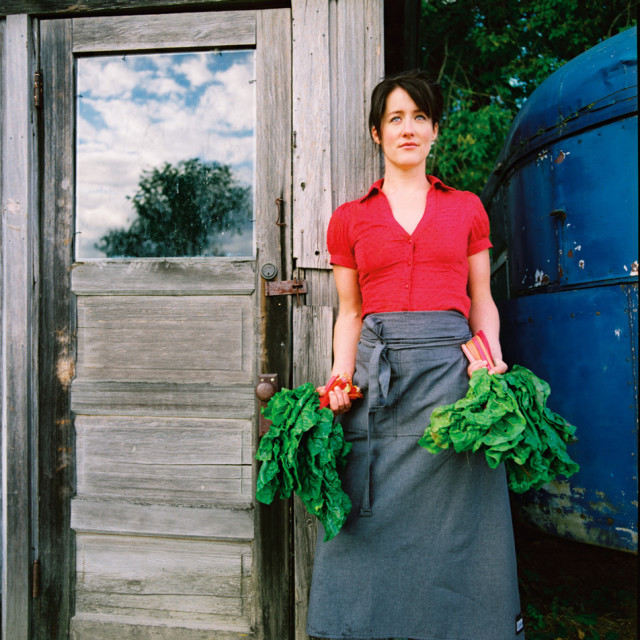
Image: Susan Seubert
Naomi Pomeroy, who recently ran the now-defunct Ripe restaurant empire with ex-hubby Michael Hebb, has rebounded with this tiny 24-seat dining room, where the open kitchen is so open there’s only a butcher’s block separating diners from the cooks. Set in a bright red, 800-square-foot building, Beast is accented by pink interior walls, soaring skylights, linen curtains sewn by Pomeroy’s mother and two long communal tables. Though it offers a prix fixe dinner menu that changes nightly, you can drop in anytime during the evening to indulge. Just arrive ready for what Pomeroy describes as a meat-heavy multicourse meal, which might start out with sweet corn soup topped with truffled pork cracklings and transition to an oxtail galette with a cauliflower and sorrel gratin—in other words, a feast that draws on both culinary beauties and beasts.
KENNY & ZUKE’S DELICATESSEN
1038 SW Stark, 503-222-3354
When the New York City Jewish culinary institution known as the 2nd Avenue Deli shut its doors last year, we mourned the loss even in faraway Oregon. Lacking an equally enticing Jewish deli here in Portland, one that served pastrami on rye and a decent whitefish salad, some of us, on occasion, considered flying to New York just for 2nd Avenue Deli’s versions (although it is slated to reopen this year). Thankfully, we’ve now got a Jewish-style delicatessen to call our own. Opened by local food blogger Nick Zukin and chef Ken Gordon, formerly of Ken’s Place, and housed in the bottom of the Ace Hotel, Kenny & Zuke’s specialty is the pastrami sandwich. Made in-house, cured for five days, smoked for 10 hours, steamed for three hours, the pastrami is hand-sliced, placed between two slices of rye bread (made by their in-house baker, Tim Healy, formerly of Pearl Bakery) and finally slathered with, if you so please, chopped liver, coleslaw and Russian dressing. There are plenty of other sandwiches to choose from, not to mention latkes, cheese blintzes, bagels and challah French toast. Given the money you’ll save on air fare, you could even afford to order them all in one sitting.
LOLO
2940 NE Alberta, 503-288-3400
If Italian has served as Portland’s cuisine of the moment for the past decade, Spanish fare looks to be the next contender. Although now-defunct Tapeo opened in 1996, succeeded by Patanegra, very few tapas restaurants have followed, until Toro Bravo debuted this spring (see p. 96) and, more recently, Lolo alit on NE Alberta St. The brainchild of Giorgio Kawas, who owns Giorgio’s in the Pearl District, Lolo offers fare that’s half tapas and half raciones (larger portions), all served in a well-appointed, unhurried setting that feels a bit like a patio thanks to bright white chairs and tall picture windows that admit tons of light. From fresh pickled sardines with parsley and olive oil to sausage and caramelized figs, or a larger portion of pork albóndigas (meatballs) with ricotta gnocchi, cherry tomatoes and almond sauce, snacks range all over the culinary map, but el espíritu de España lies at their center.
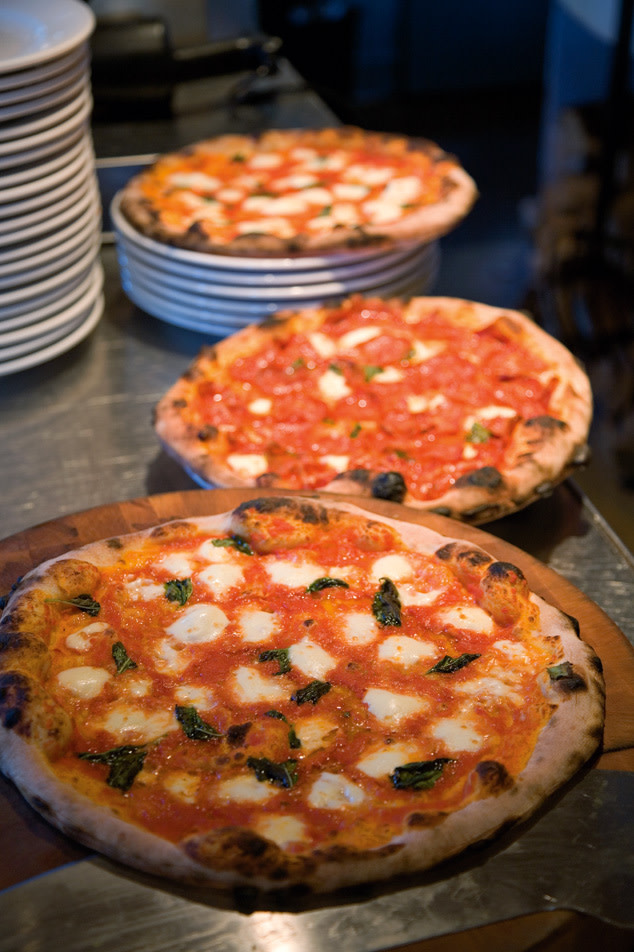
Image: Susan Seubert
KEN’S ARTISAN PIZZA
THE CLASSIC PIZZA JOINT seldom exudes anything remotely resembling ambient warmth, and it doesn’t really need to. If a parlor makes a truly good pie, the fact that there’s tomato sauce splattered on the walls or that Jimmy the Pizza Maker frazzles customers with his constant barking doesn’t matter a lick.
So when a pizzaiolo decides to open a business that is warm and inviting—classy, even—we’re naturally suspicious: How can we trust that he’s making the best pie when he’s spent all his time decorating the place? But when Ken Forkish of Ken’s Artisan Bakery in Nob Hill opened Ken’s Artisan Pizza, our doubts were assuaged.
Set in a narrow former paint store on SE 28th Ave, Ken’s is airy and light-filled, albeit minimalist in décor. At the entrance, a stack of oak logs greets customers, and behind that a rustic wood-burning pizza oven beckons. Tables are crafted from salvaged Douglas fir planks, and paint-can lights dangle from the ceiling.
But such touches have in no way compromised the quality of the pizza. Not only is it superbly rendered—a thin, Neapolitan-style crust ladeled with a piquant sauce and topped with the loveliest of ingredients from arugula to fennel sausage to house-cured pancetta—but so are just about every salad and side. An impressive, seasonal roasted-vegetable platter features anything from warm fingerling potato salad to roasted leeks, tomatoes or peppers. The Caesar salad trumps most in town, and for dessert, figs, apricots, pears or apples (depending on the season) emerge sweet and plump from the pizza oven. But even amid such a mannered approach, you may still hear that familiar barking. Except that it’s not back in the kitchen—it’s outside, coming from all those diners waiting to get in.
304 SE 28th Ave, 503-517-9951
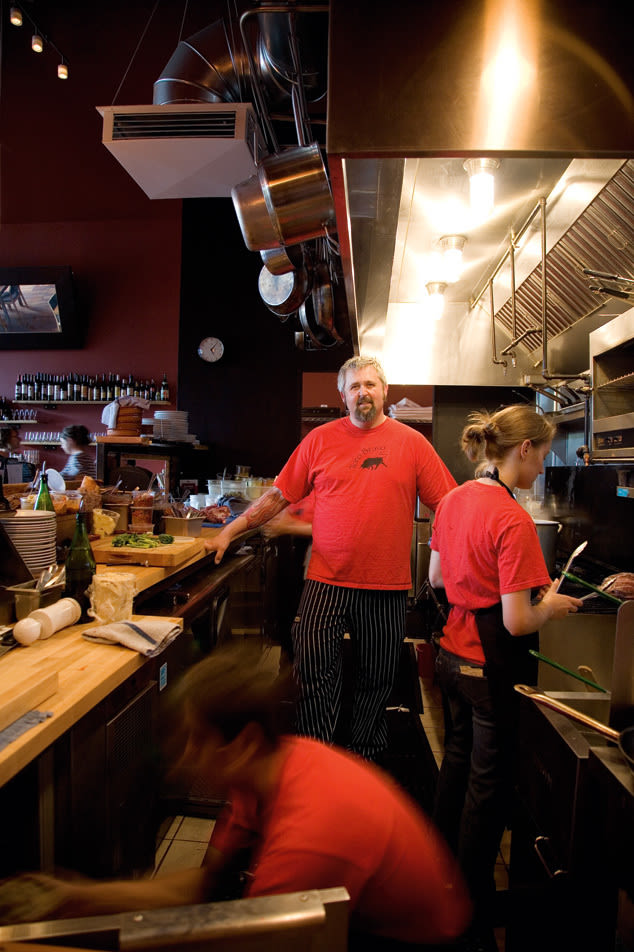
Image: Susan Seubert
CHEF OF THE YEAR
AFTER SELLING HIS SHARES in both Simpatica, the incredibly popular catering company and supper club in Southeast Portland, and Viande Meats & Sausage in Nob Hill’s City Market, seasoned chef JOHN GORHAM set out to invigorate the Spanish food scene in Portland. After a trip to Catalonia early this year, Gorham opened Toro Bravo (see p. 96) in a dramatic red-walled dining room just off NE MLK Jr Blvd, and since Toro Bravo’s debut, he’s managed to redefine tapas in our city. Using the freshest ingredients that the Pacific Northwest has to offer, Gorham reinterprets such Spanish classics as paella, tortilla Española and papas bravas, and throws in more eclectic dishes like smoked pork shoulder with heirloom tomatoes or a sherried chicken-liver mousse. In doing so, he simultaneously draws upon the signature down-home, urban-rustic flair that he’s cultivated by cooking in restaurants as far away as Ghana and North Carolina and as close by as San Francisco and Eugene. We’re just lucky he finally ended up here.
You’ve described your restaurant as serving “Spanish-inspired” tapas. Why not just call it a Spanish
restaurant?
Because I’m not Spanish, and I don’t want anyone to think that I’m trying to replicate an experience they had in Spain. One thing I learned in Berkeley, when I helped Jean-Pierre Moulle [former executive chef of Chez Panisse] open Caffe Centro, was to take your local ingredients and try to cook the way a person from another region would cook if they were transplanted to your region.
But you did go to Spain to do research before opening Toro Bravo, right? How long were you there?
Just a week.
Was it your first time?
Yes. My wife and I just stayed in Barcelona. We ate 10 meals a day for seven days straight.
Were there any restaurants there that blew you away?
Cal Pep was phenomenal—it was tapas, but it wasn’t everyone else’s tapas. There was a frito mixto with sardines, langoustines, anchovies and calamari that was just so simple. There was also a place in the Boqueria market where we got the inspiration for our eggplant with sweet pepper lamb ragout. We went to Con Costa, right on the water, which is famous for its paella and fideo [paella made with noodles].
How long did it take you to perfect your paella and fideo?
I’ve been passionate about paella for a long time, so the one I do now, I’ve done for many years. But I think I made the fideo 50 times at home before it worked.
If you’d never been to Spain before last year, how did you get the idea to open a Spanish restaurant?
I started thinking about it when I was working in the Bay Area in 1999. I was friends with Chris Rossi, who opened À Côté, a French tapas-style restaurant, and saw how much fun it was. Last year, for Simpatica’s supper club, I started playing around with tapas dinners—and they were a hit.
That might explain why you’ve had such a loyal following since opening Toro Bravo.
Something we did on purpose was keep our reasonable price point. We wanted to give people really good food for way less than you can get at other restaurants and to give them a new experience.
What ingredients have you been working with these days that you’re excited about?
I’m getting ready to case a bunch of boudins blancs [white sausages], and we’ll serve those with braised cabbage and chanterelles. As we get more comfortable, we’re pushing the charcuterie further.
What was your first restaurant job?
When I was 14, I worked as a dishwasher at a Mexican restaurant in Savannah, Ga. During the interview, I told the owner that I wanted to be a chef. Then I got a job putting pigs on a barbecue pit in Greenville, NC. When we moved to Virginia, I enrolled in a culinary program in high school.
So, your family moved a lot?
My dad was a corporate manager for the Kroger grocery chain in the Southeast. He’d move us around and open and close and remodel stores from Virginia to the Florida border.
Did you eat out a lot as a family?
A lot. Family-style restaurants, mostly. When we lived in Savannah and Myrtle Beach, SC, there was a lot of good seafood, and my parents loved that, so we went to fish houses.
Which Portland chefs have influenced you over the years?
Definitely Vitaly Paley. We’re really good friends. My wife was the floor manager there for four years. When I first came here in 2000 and started working for Fratelli, and then Tuscany Grill, Vitaly set me up with a lot of the farmers he used.
Paley’s Place was recently featured in yet another article about Portland’s food scene in the New York Times. Why do you think that newspaper loves Portland so much?
It’s funny. A lot of New York chefs I’ve cooked with miss that heart-and-soul of cooking that Portland has. We’re not trying to make it something that it’s not. It’s rustic.
Your restaurant is definitely rustic. Are you interested at all in doing anything fancier down the road?
No. I am who I am. I like working with farmers. I’ve always been a purist. I don’t like tweaking things out. Combinations go together for a reason. I’m at a point in my life where I’m kind of done playing with food.
